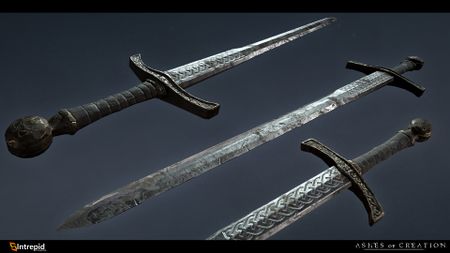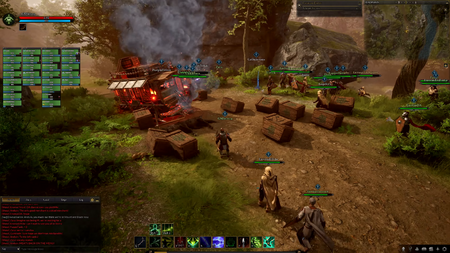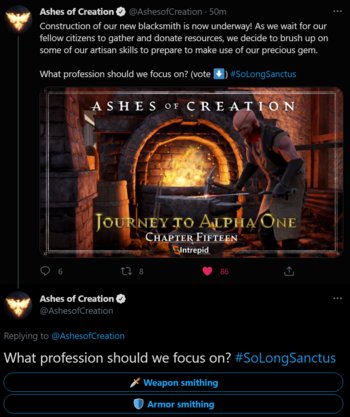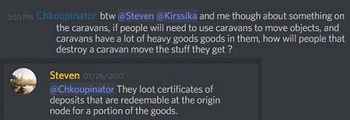Item sinks
It's important for a healthy economy to have item sinks, so that anything that can be crafted can also be destroyed:[1]
- Over-enchanting carries the risk of destroying that item[2], rendering it useless for use temporarily.[3]
- Players gain craftable items and recipes from deconstructing (salvaging) completed items.[2]
- A portion of resources and materials are lost when caravans or nodes are destroyed.[4]
- Corrupted players who die can lose gear.[5]
- Item durability (item decay) does not destroy items, but it acts as a materials sink.[5][6][7] Zero percent durability will unequip an item, increasing its repair costs.[8]
An important aspect of a healthy economy is having some item sinks available... There are three kinds of item sinks: You can gain craftable items from deconstructing completed items; You can have decay... and if you want to over-enchant that item there will be a potential to destroy it as well. It's important for an economy to experience those types of emphasis on what can be crafted as well as seeing those items that are crafted be destroyed as well..[7]
The concept there is this is part of the engine that is supply and demand. So the server is constantly generating these materials on tick as they propagate throughout the world and get repopulated, players are going out there and collecting these things. We want to make sure that there is a driving force and factor behind what crafters and gatherers are out there doing: There's constantly going to be a demand for them to supply these things. Whether that death is from PvP or from PvE these are going to be necessities for players to constantly provide.[6] – Steven Sharif
Power creep
The developers intend to limit power creep via item sinks, the lack of gear binding, and the absence of pay-to-win or pay-to-convenience in Ashes of Creation.[9]
Item durability

The decay system is not going to be some worthless "Oh I'm just going to throw some gold into this and it's a simple gold sink". It's actually going to require some base materials in order to repair decayed items; and decay occurs from death and also the destruction and disable system. For the weapons over the over-enchanting will require those materials as well. So creating that dependency I think is healthy for the crafting economy.[10] – Steven Sharif
There is item durability (item decay) in Ashes of Creation.[7]
- Item decay does not destroy items, but it acts as an materials sink.[5][6][7]
- If you allow it to get to certain stages, or to get to a destructed stage then it requires a lot of material components in order to return back to its former glory.[13] – Steven Sharif
- Over enchanting an item comes with the risk of durability loss if a safety margin is exceeded.[10][16][17]
- There is durability in the game... It's not going to be a trivial durability. There is a potential to destroy gear (weapons and armor), but there is also an ability to reforge that destroyed gear using a portion of the materials necessary as well as finding an item creator who can reforge it.[7] – Steven Sharif
Item repair

For example: if you have an iron sword and then the sword gets damaged from use, you have to use more iron to repair it; and what that does is... make sure that there's significant sinks in the game for base materials so that you are creating a scarcity and demand that's present on the creation of higher goods as well as supplying the necessary decay components for the world.[15] – Steven Sharif
Item repair will cost crafting materials.[6][15][7]
- 0% durability will unequip items, increasing its repair cost.[8]
- Damaged gear can be reforged at a player stall using a portion of the materials that were necessary to craft the item.[10][14][15]
- There may be additional constraints for repairing "very unique items", such as having a crafter and recipe to effectuate repairs. This is subject to testing.[5]
- There is no limit to the number of times an item can be repaired.[19]
There will be ways to repair destructible structures (such as walls and gates) and also repair (or re-craft) siege weapons that were damaged during sieges.[20]
- There's a lot of ancillary activities that can be had during sieges... It's obviously strategy and tactics and raid-versus-raid components, but also you want to have individual contributions where players can do things during the siege to aid in the greater effort so to speak; and it doesn't require you having 50 people by your side to effectuate that influence over something. So repairs are great ways to do that. Repairs for walls, repairs for gates, being able to spawn and essentially craft the designs for specific types of siege weapons to provide those to the team.[20] – Steven Sharif
Item deconstruction
Players gain craftable items and recipes from deconstructing (salvaging, dismantling, disenchanting) completed items.[2]
- There's salvaging where you can deconstruct an item to get components only capable of retrieving from salvaging an item that can be used in crafting other types of items.[1] – Steven Sharif
- Specific and necessary crafting materials for higher tier items can only be obtained through the deconstruction of lower-tier items. This is designed to keep lower tier crafted gear relevant through progression and across expansions.[21][22][1]
- Specific crafting components yielded by gear deconstruction, and some of these components can be only be obtained from gear of certain enchantment levels and type of equipment. These components are needed for certain recipes for gear and other ancillary crafting professions. But the itemization team is still ironing out some of these flows.[21] – Steven Sharif
- Item deconstruction will not be a meaningful way of circumventing restrictions on transit of resources and materials.[23]
Enchanting
Enchanting is not an artisan profession in its own right. Scribes create scrolls that can be utilized by different professions to create enchantments relating to that profession.[24][25]
- Enchantment scrolls can be sold on the open market.[26][24][27]
- Enchanting does not increase an item's level requirement.[28]
- You don't really push a particular item's level requirement or the identity of that item. You can enhance it, you can add enchantments to it, but it's still the item it is.[28] – Steven Sharif
Enchantments
A few different professions participate in the creation of enchantment scrolls. Those enchantment scrolls are primarily going to be interfaced on the profession side with scribe, but once that scroll is created then it's in the hands of the open economy and players may utilize them to enchant weapons and stuff.[24] – Steven Sharif
Mechanisms for achieving the safer enchantment routes would mainly be through very rare material acquisition and boss kills.[29] – Steven Sharif
There are two types of enchantments for items: Vertical and horizontal.[30]
- Vertical enchantments are a power progression for a crafted item. More damage or mitigations, added effects or bonuses.[26] Vertical enchantments include risks.[30]
- There isn't RNG in crafting but there may be a small amount of RNG in enchanting.[31]
- Over-enchanting items comes with a potential risk that the item decays or is destroyed if a safety margin is exceeded. This system is subject to testing.[32][16][17]
- It's a progressive tier of risk. At lower levels you have opportunities to potentially lose out on the pluses instead of breaking the equipment. But when you reach a certain threshold, there is an opportunity to essentially destroy the equipment, where you get resources back. But that's a risk that the player takes.[32] – Steven Sharif
- Lower levels of over-enchanting carries the risk of losing bonuses on the item. Over-enchanting beyond a certain threshold carries the risk of destroying the item and gaining resources back.[32][16][17]
- There may be mechanisms for achieving safer over-enchantments, such as difficult to obtain enchantment scrolls, or very rare material acquisitions.[21][29][16]
- Personally, I am fine with RNG in enchantment, so long as there are special ways to mitigate the RNG with investment, to a degree. For example, difficult to obtain enchantment scrolls that insure enchantment efforts, and including a buffer of safe enchantment in earlier pluses.[21] – Steven Sharif
- Horizontal enchantments are more situational. For example: I'd like my sword to do force damage instead of holy damage because the monsters I tend to fight are incorporeal.[30]
Caravan destruction

This caravan was loaded with a combination of, it looks like commodity crates and material crates.[33] – John Collins
If a caravan is destroyed or it despawns it becomes a wreckage that contains a portion of the cargo it was transporting.[34][33][35][36][37][38][39] The remainder of the caravan's goods are sunk (lost) when the caravan is destroyed.[35][40]
- When a caravan gets destroyed it creates a wreckage. That wreckage will have a number of the supplies that the caravan was carrying; and when stolen by attackers those supplies become essentially stolen glint, or corrupted glint, and stolen resources that the caravan was hauling. If they are commodities they can maintain their commodity type, and players will have to summon a caravan from a nearby node that would be empty in order to haul those crates back. You can also break into the crates or the cargo itself instead of hauling the cargo as a completed shipment. Doing so reduces the number of total resources that you can gather from the crate. So a portion of it is sunk to the system; and then a portion of it gets sunk further if you choose to break open the crates versus attempting to haul them back.[35] – Steven Sharif
- Commodities crates are marked with a green symbol. Materials crates are marked with a black symbol.[33]
- Anyone may loot a caravan's wreckage.[40]
- Unsealing crates (by breaking open sealed crates) yields less value than transporting the sealed crates for unloading.[41] This is in addition to the value already lost when the caravan was destroyed.[42][35][43][44]
- Caravan components are destroyed if the caravan is destroyed.[45][36] Previously it was stated that components may drop when a caravan is destroyed.[46]
- Q: What is the reason for requiring the destruction of a caravan by the attackers as opposed to the attackers gaining possession of the caravan?
- A: With caravans we really want to emphasize this idea of not necessarily stealing the vehicle, but being forced to achieve victory through destruction; and when you do, you then have the logistical issue of how you're going to transport those goods on your own rather than servicing the transport of that by just hijacking.[47] – Steven Sharif
- In an earlier design iteration, prior to the introduction of cargo crates, it was proposed that destroyed caravans dropped certificates for heavy goods that were redeemable at the origin node for a portion of the goods.[48][39]
- There is no limit to the number of times caravans can be commandeered or the number of times caravans get destroyed and replaced.[49]
See also
References
- ↑ 1.0 1.1 1.2 Livestream, May 10, 2017 (10:47).
- ↑ 2.0 2.1 2.2 Livestream, May 8, 2017 (20:41).
- ↑ Interview, July 30, 2020 (16:17).
- ↑ Interview, July 18, 2020 (55:01).
- ↑ 5.0 5.1 5.2 5.3 Livestream, May 28, 2021 (1:53:04).
- ↑ 6.0 6.1 6.2 6.3 6.4 6.5 Interview, February 7, 2021 (13:14).
- ↑ 7.0 7.1 7.2 7.3 7.4 7.5 Podcast, 2017-05-13 (25:55).
- ↑ 8.0 8.1 8.2

- ↑ Interview, October 20, 2018 (2:53:52).
- ↑ 10.0 10.1 10.2 10.3 10.4 Interview, July 29, 2020 (16:46).
- ↑ Podcast, May 5, 2017 (43:05).
- ↑ Livestream, August 28, 2020 (2:05:07).
- ↑ 13.0 13.1 Podcast, September 29, 2021 (32:35).
- ↑ 14.0 14.1

- ↑ 15.0 15.1 15.2 15.3 Interview, July 19, 2020 (51:11).
- ↑ 16.0 16.1 16.2 16.3 Interview, July 29, 2020 (15:04).
- ↑ 17.0 17.1 17.2 Livestream, May 5, 2017 (20:41).
- ↑

- ↑ Livestream, September 30, 2020 (1:01:45).
- ↑ 20.0 20.1 20.2 Livestream, May 28, 2021 (1:04:29).
- ↑ 21.0 21.1 21.2 21.3

- ↑ Livestream, July 30, 2021 (1:16:05).
- ↑

- ↑ 24.0 24.1 24.2 Livestream, May 27, 2022 (1:20:00).
- ↑ Livestream, May 26, 2017 (51:37).
- ↑ 26.0 26.1 Livestream, November 30, 2023 (1:38:47).
- ↑ Livestream, May 17, 2017 (58:55).
- ↑ 28.0 28.1 Livestream, March 26, 2021 (1:15:57).
- ↑ 29.0 29.1

- ↑ 30.0 30.1 30.2 30.3 30.4

- ↑

- ↑ 32.0 32.1 32.2 Interview, July 9, 2023 (1:50:10).
- ↑ 33.0 33.1 33.2 33.3 Video, January 31, 2024 (6:47).
- ↑ Livestream, January 31, 2024 (1:07:42).
- ↑ 35.0 35.1 35.2 35.3 Livestream, October 31, 2023 (1:18:33).
- ↑ 36.0 36.1 Livestream, October 31, 2023 (1:08:22).
- ↑ Livestream, May 15, 2017 (45:20).
- ↑ Livestream, December 15, 2017 (1:04:25).
- ↑ 39.0 39.1 Interview, April 15, 2019 (26:59).
- ↑ 40.0 40.1 Livestream, April 30, 2021 (1:04:23).
- ↑

- ↑

- ↑

- ↑ Interview, September 10, 2023 (53:47).
- ↑ Livestream, January 31, 2024 (1:05:07).
- ↑ Interview, April 15, 2019 (28:28).
- ↑ Livestream, September 30, 2022 (1:17:13).
- ↑

- ↑ Livestream, February 29, 2024 (1:27:36).